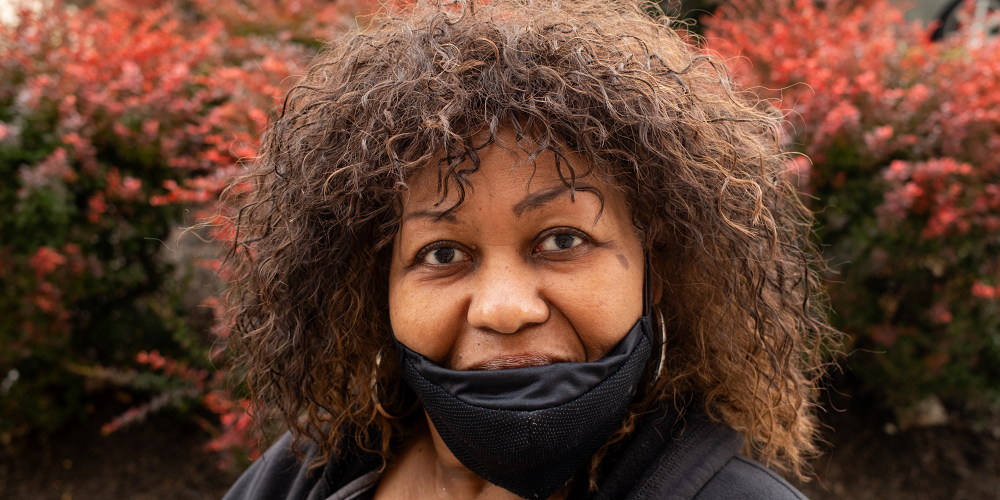
What would happen if you couldn’t drive for a week? For most of us, it sounds impossible. We jump in our cars to go to work, the grocery store, or meet friends. But for thousands of Marylanders, this is everyday life. Cookie Lockley has been using Maryland Transit Administration’s paratransit service, MobiltiyLink, since 2002, and her story shows us why we all need to experience what it’s like to get around without our cars and participate in Week Without Driving.
Meet Cookie
Cookie has been riding Mobility for over 20 years. She uses an electric scooter to get around and depends on buses, paratransit, and sidewalks to live her life. What she’s learned in all those years could teach every driver, city planner, and elected official important lessons about how our transportation system really works.
“I don’t want to complain,” Cookie says. “But I have had a lot of things happen [traveling around Baltimore City] and it’s stressful to me, very stressful.”
Her experiences aren’t unique. Across the state, people who can’t drive face the same challenges every day. That’s why Week Without Driving matters so much.
The Daily Reality: When Being on Time Isn’t Up to You
Mobility riders are required to make reservations 1-7 days in advance and reservations are confirmed on a first come, first served basis. On the day of the reservation Mobility is considered “on time” for a pickup if the operator arrives within 30 minutes of the scheduled pickup time. On busy days Mobility is known to be later than 30 minutes and sometimes doesn’t show up at all. This makes scheduling appointments tricky especially when many service providers (doctors, dentists, etc.) will turn you away if you are 15 minutes or more late.
This isn’t just about missing a lunch date or a birthday party, although those things are important, too. When you depend on mobility service, medical appointments become a guessing game. Do you risk being turned away from important healthcare appointments because your ride might be late? Do you cancel and try again another day?
Cookie calls it “like shooting dice – you don’t know what you’re gonna roll.”
The Bumpy Road: When Transportation Hurts
Most of us think of our cars as comfortable spaces. We adjust our seats, control the temperature, and play our favorite music. But for people using mobility transportation, the ride itself can be painful.
“I thought that an ambulance ride was terrible,” Cookie says. “No, mobility got it beat.” When you’re secured in a wheelchair or scooter, every sudden stop sends you sliding forward. Every sharp turn makes you lean into the window.
Imagine if every car ride left you sore, stressed, and exhausted. How would that change how often you left your house? How would that impact your quality of life?
PART 2
The Sidewalk Problem Most People Never Notice
Before Cookie started using a scooter, she might not have noticed the problems with sidewalks. But now she sees them everywhere – concrete pushed up by tree roots, missing pieces that could trap a wheel, poles placed right in the middle of walkways.
“…the roots underneath have pushed the concrete up,” Cookie explains. “One was up so high, it looked like a step.”
So Cookie rides in the street, which is dangerous but often easier to navigate than broken sidewalks. This is something most pedestrians never think about. We step over cracks or walk around obstacles without thinking. But for someone using a wheelchair or scooter, these aren’t minor inconveniences – they’re barriers that can make a route impossible.
The Ripple Effect: How Transportation Affects Everything
When your transportation is unreliable, it affects every part of your life. Cookie talks about places she’d like to go but doesn’t because she’s afraid of being stranded for hours because Mobility is late. She chooses her destinations based on which ones have backup bus routes.
“I don’t like the feeling of being stranded,” she says. “I’d like to go to Costco over on the east side of the city, but I don’t know the bus route.”
This means Cookie can’t shop where she wants, can’t visit friends in certain neighborhoods, and can’t explore her own city. Her world gets smaller because her transportation options are limited.
Cookie used to work, but unreliable transportation made it impossible to keep a job. “They would come late to get me to work. And it wasn’t no more than about 10 blocks.”
What Decision Makers Would Learn
Cookie believes that if elected officials had to live without driving for a week, they would completely change how they think about transportation.
“I really, really think that they would change their whole perspective of how it is to get around,” she says. “Especially getting around on just one or maybe two types of accessible vehicles.”
She’s right. Most decision makers drive to work, drive to meetings, drive to the grocery store. They may have never had to wait two hours for a bus or Mobility service that might not show up. They may have never had to choose between missing a medical appointment and risking their safety.
The Human Cost of Bad Transportation
Behind every transportation policy decision are real people like Cookie. She talks about friends who can’t leave their apartments, people who miss medical appointments, and workers who can’t get to their jobs on time.
“A lot of things, stories I’ve heard, I almost want to cry.” Cookie says.
She’s not asking for special treatment. She’s asking for the same thing many drivers take for granted – the ability to get where she needs to go, when she needs to be there, safely and comfortably.
Why We All Need to Try a Week Without Driving
Cookie’s story shows us that transportation isn’t just about buses and trains. It’s about freedom, independence, and the ability to participate in your community. When transportation doesn’t work, people get left behind.
“Just because you’re driving don’t mean you’re going to drive forever,” Cookie reminds us. “You could be in a horrible accident, God forbid, and you might need a service like mobility.”
Again, she’s right. Any of us could find ourselves needing accessible transportation. We could have an injury, develop a disability, or simply unable to drive safely. When that happens, we’ll depend on the same system that Cookie uses every day.
Check Back for Part 3…
PART 3
Making Transportation Work for Everyone
Cookie has simple ideas for making transportation better. She wants buses that run on time, drivers who care about passenger safety, and enough vehicles so people don’t have to wait for hours. She wants sidewalks that work for everyone and transportation that connects all parts of the city.
These aren’t impossible dreams. They’re basic expectations that most drivers already have for their daily commute.
The Challenge: Will You Try It?
Week Without Driving challenges all of us to experience what Cookie lives every day. Can you get to work without your car? Can you buy groceries, go to the doctor, or visit friends using only public transportation?
For some people, this will be easy. They live in areas with great public transit, bike lanes, and walkable neighborhoods. For others, it will be eye-opening. You’ll discover that the bus doesn’t run to your neighborhood, that sidewalks end suddenly, or that a simple trip to the store takes three hours.
“I just hope that this will open their eyes to see, to really see what we need,” Cookie says about decision makers trying Week Without Driving.
The Bigger Picture
Cookie’s story isn’t just about transportation. It’s about how we build our communities and who we include in them. When we design cities around cars, we make it harder for people like Cookie to participate fully in society.
But when we invest in good public transportation, accessible sidewalks, and connected communities, everyone benefits. Parents with strollers, elderly people who can’t drive, teenagers who haven’t gotten their licenses yet, people who can’t afford cars – they all get more freedom and independence.
“We do need that funding to better transportation for people with disabilities,” Cookie says. “I really feel for the ones who can’t get out of their chairs.”
Your Turn to Experience the Difference
Cookie has been navigating Baltimore’s transportation system for over 20 years. She’s learned to plan backup routes, to carry phone numbers for late buses, and to choose her destinations based on which ones she can reach.
But she shouldn’t have to be an expert in transportation logistics just to live her life. And neither should anyone else.
That’s why Week Without Driving matters. It’s not just about proving you can survive without your car. It’s about understanding what millions of Americans face every day and working to make transportation better for everyone.
So, will you take the challenge? Will you try a week without driving and see your community through Cookie’s eyes? You might discover that the problem isn’t just about buses and trains – it’s about how we build our world and who we leave behind.
“Anything can happen in the blink of an eye,” Cookie reminds us. “People should be aware of that.”
She’s right. Today you might be behind the wheel. Tomorrow you might be waiting for the bus. The question is: what kind of transportation system do you want to be there when you need it?
